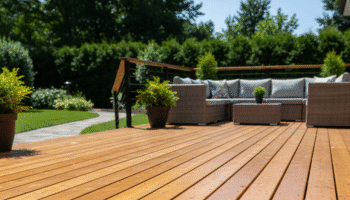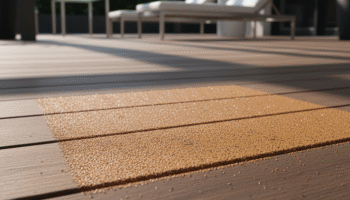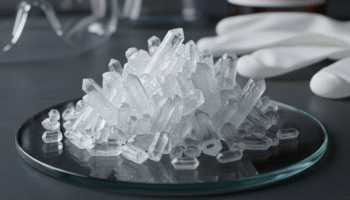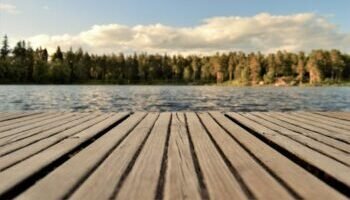How to Clean a Wood Deck Without Pressure Washing (Safe Methods)
If the thought of blasting your deck with a pressure washer makes you nervous, you’re not wrong. Wood is tough, but it’s also easy to scar, soak, and fuzz up with high PSI. The good news: you can get a wood deck truly clean—safely—without a power washer. Below I’ll show you the gentle, chemistry-first method I use on everything from 50-year-old cedar to brand-new pressure-treated lumber, plus fixes for mold, grease, rust, and more.
Quick win: the core recipe is 2 cups powdered oxygen bleach + 5 gallons warm water, 20-minute dwell, scrub with a stiff deck brush, rinse with a garden hose, then apply a deck brightener (oxalic acid). That’s it—no pressure washer needed.
Why Pressure Washing Can Damage Your Deck
Wood Fiber Damage & Splintering
High pressure shears off the soft spring wood and rips surface fibers, leaving the boards fuzzy (called “furring”). That fuzz turns into splinters and traps dirt faster next time—so you end up cleaning more often and sanding sooner. I’ve repaired hundreds of decks with deep gouges and shaggy grain caused by improper pressure washing, and most of that damage was avoidable with a brush and the right cleaner.
Water Penetration Issues
A strong jet forces water deep into checks and end grain. That moisture doesn’t just evaporate—it lingers inside the board, encouraging rot from within. I routinely see rot appear 2–3 years after repeated high-pressure cleanings because water was driven past the surface where sun and wind can’t dry it.
Raised Grain & Furring Problems
Even when you avoid gouges, high PSI lifts the grain and opens pores. The deck looks “clean,” but the rough, raised surface now grabs dirt and foot traffic wear. You’ll have to sand (and lose years of wood life) to get it smooth again.
When Pressure Washing Is Actually Appropriate
Pros sometimes soft-wash decks using detergents and low pressure (well under 500 PSI) to rinse loosened grime. The chemistry does the work; the water only carries it away. If you hire out, confirm they’re using a soft-wash process—full-blast pressure isn’t needed for wood.
This no-pressure method fits neatly into your annual exterior plan in the Exterior Wood Care Guide, and slots directly into prep sequences outlined in the Deck Care Encyclopedia. For exact dilution ranges, dwell times, and when to brighten after cleaning, use Deck Cleaning Solutions.
The Gentle Cleaning Method: Step-by-Step Guide
Tools You’ll Need (No Power Washer Required)
- 5-gallon bucket & measuring cup
- Powdered oxygen bleach (sodium percarbonate)
- Deck brush with a stiff, non-metal bristle head (8–10 in. block) + pole
- Garden hose with adjustable nozzle (fan pattern)
- Protective gear: gloves, eye protection
- Plastic sheeting to shield landscaping & nearby metal
- Deck brightener (oxalic acid) for after-cleaning pH balance and color reset
- Optional: pump sprayer (for even solution application), plastic putty knife for debris in gaps
Pro tip from the field: manual scrubbing gives you total control and forces you to inspect every board, so you catch popped fasteners, soft spots, or cupping early—before they become costly repairs.
Pre-Cleaning Inspection & Preparation
- Tighten loose screws, set proud nails, and mark boards that feel spongy or split.
- Check railings and stairs for wobble.
- Tape off aluminum rails and move planters; pre-wet plants and siding to buffer against splashes.
Clearing Furniture & Debris
- Remove furniture and mats.
- Sweep thoroughly; use a plastic putty knife or 5-in-1 tool to clear debris in board gaps so rinse water drains freely.
Best Deck Cleaning Solutions (DIY & Commercial)
Oxygen Bleach Method (Most Effective)
- Mix 2 cups powdered oxygen bleach with 5 gallons warm water. Stir until dissolved.
- Pre-wet a manageable section (20–30 sq ft).
- Flood the area with solution (brush or pump sprayer). Wait 15–20 minutes—keep it wet; re-apply as needed.
- Scrub with the grain using moderate pressure.
- Rinse thoroughly with a garden hose.
Why it works: oxygen bleach releases active oxygen to break down organic grime, mold, and mildew without bleaching wood tone or corroding fasteners. In my experience, this outcleans most pressure-wash passes with zero risk of fiber shredding.
Dish Soap Solution (Light Cleaning)
For routine dust and pollen: 2–3 tbsp mild dish soap in 2 gallons warm water. Great mid-season refresh when there’s no heavy staining.
Vinegar & Water Mix (Mold Treatment)
A 1:1 white vinegar and water solution helps suppress light surface mold and neutralize odors. Allow 10–15 minutes of dwell before a gentle scrub and rinse. (For heavy growth, use oxygen bleach first, then follow with brightener.)
Commercial Deck Cleaners Worth Buying
Look for oxygen-based or citric acid formulas labeled safe for wood decks (and safe for plants when used as directed). Avoid products that lean on high chlorine content or “instant brightening” by harsh bleaches.
What NOT to Use (Chlorine Bleach Warning)
Regular household (chlorine) bleach can strip natural color, damage nearby vegetation, pit metal hardware, and leave residue that interferes with stain adhesion. If you must spot-treat algae, dilute heavily and neutralize afterward with a brightener—but I recommend oxygen bleach instead.
Proper Scrubbing Technique
Choosing the Right Brush
Use a stiff, synthetic bristle deck brush on a pole. Avoid wire brushes (they shed metal that rust-stains and can scratch fibers).
Working With the Grain
Scrub along the grain, not across it. Short, overlapping strokes lift grime without cross-cutting fibers. Let the chemistry loosen dirt—you’re guiding, not grinding.
Section-by-Section Approach
Work in small zones so cleaner doesn’t dry. Keep a “wet edge,” maintain dwell time, scrub, and rinse immediately. On hot days, start in the shade and mist surfaces to maintain moisture.
Rinsing Without High Pressure
Garden Hose Techniques
Use a fan pattern and keep the nozzle 12–18 inches off the surface. Rinse with the grain from house outward so dirty water runs off the deck, not back onto cleaned boards.
Low-Pressure Spray Nozzles
If you have an adjustable nozzle, stick to low pressure. The goal is to carry away loosened soil, not blast into the wood.
Preventing Water Pooling
Clear gaps, brush water off flat areas, and verify slight slope away from the house. Standing water leaves mineral rings and slows drying.
Deck Brightening: The Final Step
What Is Deck Brightener?
A brightener is a mild acid wash that resets wood pH after alkaline cleaning and restores natural tone. It instantly removes dark tannin and metal-reactive stains and closes the cleaning cycle.
Oxalic Acid Treatment
Mix and apply per label; keep wet for 5–10 minutes. You’ll see gray/yellow tones snap back to fresh wood color. Rinse thoroughly. I never skip this step—brightener is the difference between “clean” and “ready to finish.”
Why This Step Matters
Neutral pH improves stain/finish adhesion and promotes even color. Skipping brightener is a top reason new stain looks blotchy or fails prematurely.
Special Cleaning Scenarios
Removing Stubborn Stains (Grease, Oil, Rust)
- Grease/Oil: Blot with absorbent (cat litter), pre-treat with a small dab of dish soap, then oxygen bleach wash.
- Rust: Spot-treat with oxalic acid (that’s what brightener is), dwell, then rinse.
- Tannin/Leaf Stains: Oxygen bleach followed by brightener removes the brown “shadow.”
Dealing with Heavy Mold/Mildew
Pre-wet, apply oxygen bleach, re-wet to maintain full dwell, scrub, rinse, brighten. For dense growth on shaded decks, a second pass after lunch once the wood has warmed up often finishes the job.
Cleaning Weathered/Gray Wood
Gray is oxidized lignin, not dirt. Oxygen bleach removes grime; brightener revives color. Don’t reach for a sander unless fibers are fuzzy—clean chemistry first, then evaluate.
Cedar Deck Specific Concerns
Cedar is soft. Keep brushes moderate (not extra-stiff), extend dwell so the cleaner does the lifting, and rinse gently. I’ve used the same oxygen bleach + brightener routine on delicate cedar with zero surface fuzzing—because the pressure stayed low.
Drying Time & What to Expect
How Long Before You Can Stain/Seal
Typical dry time after a full clean and brightener is 24–48 hours, longer in cool/humid weather or shaded areas. For best results, use a moisture meter and aim for ≤15% wood moisture before staining. Visually, boards should look evenly dry with tight grain.
Maintenance Cleaning Schedule (Between Deep Cleans)
- Monthly: Sweep and clear gaps so leaves don’t compost on boards.
- Quarterly: Quick hose-down and spot scrub of traffic lanes.
- Seasonally (Spring/Fall): Light oxygen-bleach wash and rinse—no need to deep scrub every time.
- After Storms: Remove mats and planters so trapped moisture doesn’t stain.
Routine maintenance keeps organic growth from rooting into the grain—so every future clean is easier and faster.
When to Call a Professional Instead
Hire a pro if you see structural soft spots, persistent green/black growth that returns quickly, deep gouges from past pressure washing, or if you plan to strip failing stain before a new finish. Ask for a soft-wash process under 500 PSI with wood-safe cleaners and a post-clean brightener. If you’re local, our team at Crawford can handle deep restoration, stain removal, and re-finishing the right way.
Cost Comparison (DIY vs. Power Washer Rental)
- DIY chemistry + tools: oxygen bleach ($10–$20), brightener ($15–$30), deck brush ($15–$30), odds and ends ($10).
- Pressure washer rental: typically $50–$100/day plus risk of fiber damage, gouges, and water intrusion that costs far more later.
From years on the job, I can tell you: letting chemistry work saves wood and money.
Deck washing should follow the timing outlined in the Deck Care Encyclopedia, with chemistry selection guided by the comparisons found in Deck Cleaning Solutions.
FAQ
Can you clean a deck effectively without a power washer?
Yes. With oxygen bleach, proper dwell time, and a stiff brush, you’ll remove embedded grime and spores better than blasting with high PSI.
What’s the best brush for scrubbing a wood deck by hand?
A stiff, synthetic deck brush on a pole (8–10 inches wide). Avoid wire.
What’s a safe homemade deck cleaning solution (no chlorine bleach)?
For deep cleaning: 2 cups powdered oxygen bleach + 5 gallons warm water. For light dirt: a few tablespoons of dish soap in warm water.
How do I remove mold from a deck without pressure washing?
Pre-wet, apply oxygen bleach, keep it wet 15–20 minutes, scrub with the grain, rinse, then apply a brightener.
Should I brighten after cleaning?
Absolutely. Brightener (oxalic acid) restores color, neutralizes pH, and helps stain bond evenly.
Pressure-Treated Lumber Care
When to Stain & What Products Work If you just built a brand-new green deck…
Non-Slip Deck Coatings
Grip Additives vs Textured Stains vs Strips Safety-first, solution-oriented guide to stop slip-and-fall accidents on…
Deck Cleaning Solutions
Oxalic Acid vs. Sodium Percarbonate Mini-plan (what you’ll get): Layman-friendly chemistry so you pick the…





